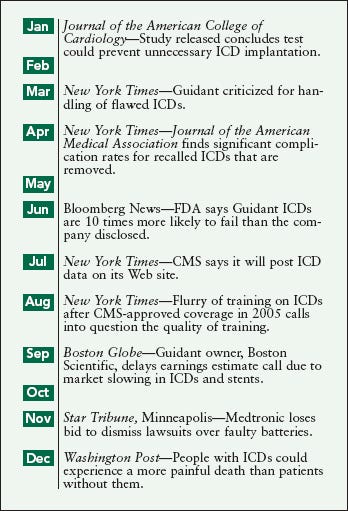February 1, 2007
MOVERS AND SHAKERS 2006
Implantable cardioverter-defibrillators (ICDs) suffered from a loss of reputation in 2006, but the debate also spurred action from several groups that could change the industry in regard to how manufacturers should handle recalls. The debate rages on, as industry juggles the opinions of the medical community, the government's response, and the need to convince the public that industry is doing everything it can to produce safe and effective devices.
In 2005, serious malfunction issues concerning ICDs from major manufacturers were brought to light, and bad press continued into 2006. “The hypercoverage from the media, in particular the New York Times' stories, has hurt the reputation of all ICDs,” says Thomas Gunderson, senior healthcare analyst for Piper Jaffray & Co. The scandal spurred increased scrutiny from FDA, motivated a response from CMS, and prompted a panel discussion from the Heart Rhythm Society (HRS). The results of those actions are still playing out.
In July 2006, CMS decided to post data on its Web site about ICDs. Those data showed about 4% of patients having at least one complication during an implant. Although those complication rates varied by doctor and hospital, the decision to post such information was understandable given the growing public demand for disclosure about medical procedures. CMS had also released a tentative plan to cut payments for defibrillator implants by one-fifth. Much to the relief of industry, CMS removed that language from its plans in August.
Also in August, HRS released a 24-page report based on the panel discussion. The report detailed a coordinated approach that was widely lauded by industry.
Among other practices, the report advocated using wireless and remote monitoring for identifying abnormal devices automatically, establishing an independent committee of experts to analyze device performance and to recommend appropriate actions, and having device makers communicate directly with patients to notify them of potential malfunctions. The recommendations also stressed the need to provide a standardized format for reporting a pertinent device.
Most notably, the report suggested that FDA stop using the word recall in public communications about problems with heart devices, on the theory that consumers believe that a recalled device must be removed immediately. HRS said that the word tends to cause alarm because it implies that the product is unsafe and the problem is so serious that the product must be fixed or replaced immediately. But as applied to devices, it often just means that the device could fail, and may not imply that it is life-threatening. In non-life-threatening cases, the terms advisory notice or safety alert would be more appropriate, the report stated.
|
Stories about implantable cardioverter-defibrillators appeared in several major news outlets nearly every month in 2006. |
Most of industry agrees. “There is no question the terminology is confusing,” says Larry Pilot, a partner at McKenna, Long & Aldridge LLP (Washington, DC). “The language should be changed.” Pilot explains that in the 1970s, when FDA worked out the current system, the term recall worked fine. “Patients had less information at their fingertips. The first time they would have heard whether anything was wrong, it would be from the doctor, who could explain the significance.”
When FDA released its comments about the HRS report in September, it supported much of what the society said, including the expansion of its cardiac advisory panel's duties into evaluating postmarket safety and effectiveness issues. But it did not say whether it would adjust the recall language.
In November, FDA announced its plan to strengthen device monitoring with the creation of a Postmarket Transformation Leadership Team. The actions included creating internal performance measurements that track how CDRH handles postmarket issues (including recalls), revising adverse-device-event reporting, and increasing the Medical Products Safety Device Network.
The companies involved in the ICD situation have had varied luck recovering from the recalls. An FDA analysis concluded that Guidant ICDs were 10 times more likely to fail than the company had let on. However, a Cleveland Clinic study showed that among patients who had recalled devices in 2005, Guidant's devices did not increase the risk of death, compared with other recalled ICD brands. What it really demonstrates is that Guidant's failure to disclose caused more problems for the company and its patients than the faulty ICDs themselves.
Medtronic issued a safety alert to doctors for 87,000 ICDs in February 2005, saying the devices may have faulty batteries. Pilot says the company may not have even needed to recall the products, under the current FDA definition. “The complications, to my understanding, could not have come out during a normal clinical trial; the flaws could not have been predicted,” he says. “In some ways, a recall is inappropriate because it expresses a violation of action.”
However, Medtronic recently lost a bid in federal court to dismiss the hundreds of lawsuits that resulted.
Although the reputations of both companies have suffered from ICD issues, they have continued to show strong presence in the market, and FDA recently commended Boston Scientific on its efforts to fix Guidant ICDs' problems. “The worst seems to be behind them now, and the upgrades in quality and the increased visibility of the medical community to the data are helping to return a more positive view to ICDs,” says Gunderson.
Moving forward from the recall situation is entirely in the hands of industry, says Pilot. “Trade associations should step forward with a reasonable and responsible approach to changing the language of recalls,” he says. “And device companies need to stop being afraid to defend their products and processes from FDA. If FDA is not challenged, the whole system becomes weaker.”
Copyright ©2007 Medical Device & Diagnostic Industry
About the Author(s)
You May Also Like



